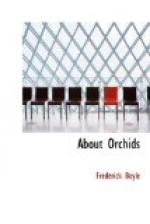In the very first place, I declare that this is no scientific chapter. It is addressed to the thousands of men and women in the realm who tend a little group of orchids lovingly, and mark the wonders of their structure with as much bewilderment as interest. They read of hybridization, they see the result in costly specimens, they get books, they study papers on the subject. But the deeper their research commonly, the more they become convinced that these mysteries lie beyond their attainment. I am not aware of any treatise which makes a serious effort to teach the uninitiated. Putting technical expressions on one side—though that obstacle is grave enough—every one of those which have come under my notice takes the mechanical preliminaries for granted. All are written by experts for experts. My purpose is contrary. I wish to show how it is done so clearly that a child or the dullest gardener may be able to perform the operations—so very easy when you know how to set to work.
[Illustration: CYPRIPEDIUM (HYBRIDUM) POLLETTIANUM. Reduced to One Sixth.]
After a single lesson, in the genus Cypripedium alone, a young lady of my household amused herself by concerting the most incredible alliances—Dendrobium with Odontoglossum, Epidendrum with Oncidium, Oncidium with Odontoglossum, and so forth. It is unnecessary to tell the experienced that in every case the seed vessel swelled; that matter will be referred to presently. I mention the incident only to show how simple are these processes if the key be grasped.
Amateur hybridizers of an audacious class are wanted because, hitherto, operators have kept so much to the beaten paths. The names of Veitch and Dominy and Seden will endure when those of great savants are forgotten; but business men have been obliged to concentrate their zeal upon experiments that pay. Fantastic crosses mean, in all probability, a waste of time, space, and labour; in fact, it is not until recent years that such attempts could be regarded as serious. So much the more creditable, therefore, are Messrs. Veitch’s exertions in that line.
But it seems likely to me that when hybridizing becomes a common pursuit with those who grow orchids—and the time approaches fast—a very strange revolution may follow. It will appear, as I think, that the enormous list of pure species—even genera—recognized at this date may be thinned in a surprising fashion. I believe—timidly, as becomes the unscientific—that many distinctions which anatomy recognizes at present as essential to a true species will be proved, in the future, to result from promiscuous hybridization through aeons of time. “Proved,” perhaps, is the word too strong, since human life is short; but such a mass of evidence will be collected that reasonable men can entertain no doubt. Of course the species will be retained, but we shall know it to be a hybrid—the offspring, perhaps, of hybrids innumerable.




